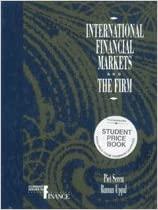Question
INVESTING YOUR OWN PORTFOLIO You have won the jackpot of a European Lottery with a prize of 30 000. After distributing a portion of the
INVESTING YOUR OWN PORTFOLIO
You have won the jackpot of a European Lottery with a prize of 30 000. After distributing a portion of the prize to a local charity, you decide that it is a good idea to invest the rest of the prize. However, you are doubtful about which asset class or financial vehicle is more suitable given the current international context.
Bear in mind that you are in your early twenties and that your financial restrictions are negligible. While you are Not a Risk Lover, you feel comfortable with a portfolio with a high risk-reward profile. You seek professional advice and contact two recognized investment advisors.
Investment Advice Summary
You had a virtual meeting with each of advisor and then you summed-up their financial advices as follows:
|
| Advisor 1 | Advisor 2 |
| Percentage invested in Bonds | 85% | 40% |
| Percentage invested in Equity | 15% | 60% |
| Investment Vehicle | Mutual Funds | Exchange Traded Funds (ETF) |
| Geographic Exposure | European Funds only | Global ETFs |
| Currency Exposure | Unhedged | 80% FX-hedging into your local currency |
| Liquidity | Low to Moderate | High |
| Portfolio management style | Active | Passive |
| Rebalancing Frequency | Every six months | Every two years |
- Asset Allocation Framework:
Based on the summary, which investment advice seems more reasonable for you? Explain your answer.
(10 points)
- Determinants of the level of interest:
Given that both advisors have recommended you allocate a portion of your portfolio into bonds, you wonder whether the ultra-low interest rates & unprecedented government policies will impact your return prospects. Analyze the effect of the following on the direction of level of interest rates and its impact on the value of bond portfolio: (5 points for each correct; total of 20 points)
- Businesses become more pessimistic about future demand for their products and decide to reduce their capital spending.
- Households are induced to save more (or spend less) because of increased uncertainty about their future Social Security benefits.
- The Central Banks undertake open-market purchases of government securities in order to increase the supply of money.
- The forward guidance signals that Central banks commit to keep the interest rates low for long (to avoid further market uncertainty and to boost economy).
- Capital Allocation Line (CAL):
After a few of weeks of deliberation, you made-up your mind and you selected an advisor, who is not any of the advisors that you initially interviewed. In a follow-up email, you learned that most of your portfolio is invested in a risky asset (global megatrends equity ETF) with an expected rate of return of 13% and standard deviation of 19%. The relevant risk-free rate is 2%. (4 points each question; total of 20 points)
- The strategic asset allocation of your portfolio is 70% in a global equity ETF and 30% in a risk-free money market fund. What is the expected return on your portfolio?
- Which is the standard deviation of the rate of return on your portfolio?
- What is the reward-to-volatility ratio (Sharpe ratio) of the global equity ETF? Which is the Sharpe ratio of your portfolio?
- Imagine that you want to draw a Capital Allocation Line (CAL) with these data, which is the value of its intercept? Which would be its slope?
- If the risk-free rate were to increase to 5%, what would happen to CAL that you have drawn?
- Portfolio with Two Risky Assets:
Sometimes you ask yourself if you should have relied on the Advisor #2. You found that Fidelity Investments offers a Passive Investment fund which is invested 40% in a global Bond ETF and 60% in a global Equity ETF. The covariance of both ETF Funds is 0.0069. The table below show the expected return and risk measures for each ETF.
Calculate the expected return and variance of the Passive Investment Fund. (5 points per each correct statistic; total of 10 points)
|
| Expected Rate of Return | Standard Deviation |
| Global Bond ETF | 4.7% | 6.1% |
| Global Equity ETF | 15 % | 23% |
- Behavioral Finance:
Since you have your own investment portfolio, you became more diligent to get financial market updates on a frequent basis. Also, you follow up the news feed of Warren Buffet, a guru of the stock market. One of his milestone strategies is called Value Investing. (2.5 points per each correct answer; total of 10 points)
- Do you believe that Buffet is subject to Anchoring when stock picking?
- Time ago, you read that Warren Buffet suggested to buy stock Biogen (BIIB). Immediately, you called your advisor and insisted that BIIB stock must be in your portfolio. Which behavioral bias explains your reaction?
- Is the Markowitz portfolio selection model compatible with Behavioral Finance? Explain your answer
- Does the performance of investors such as Warren Buffet validate a Behavioral Finance approach? Why?
Step by Step Solution
There are 3 Steps involved in it
Step: 1

Get Instant Access to Expert-Tailored Solutions
See step-by-step solutions with expert insights and AI powered tools for academic success
Step: 2

Step: 3

Ace Your Homework with AI
Get the answers you need in no time with our AI-driven, step-by-step assistance
Get Started


